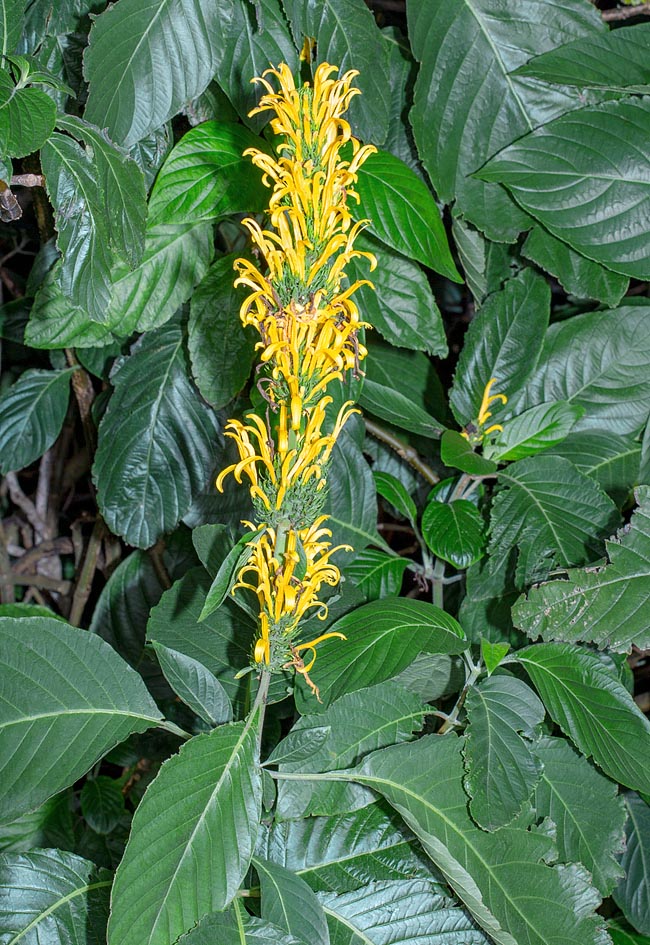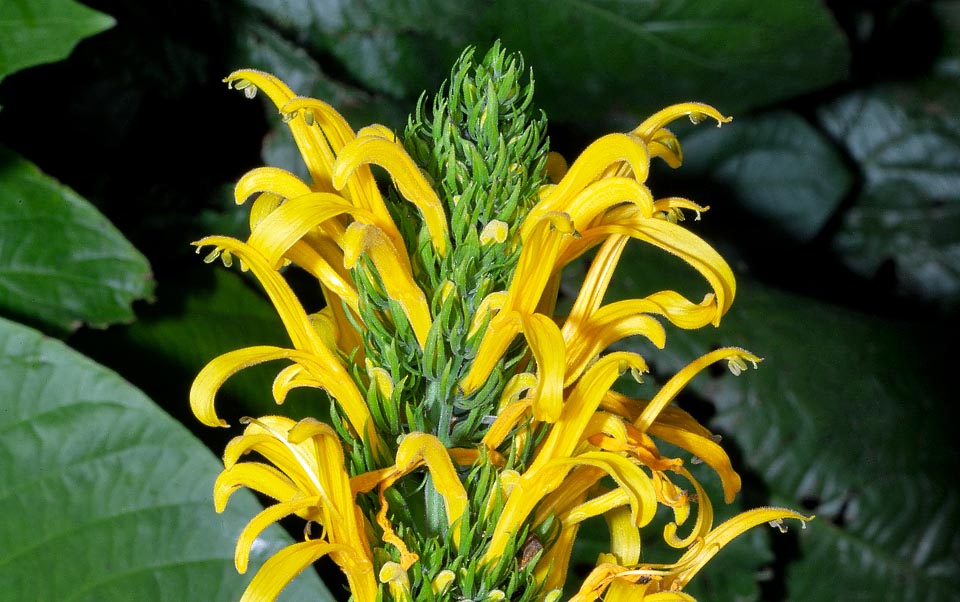Family : Acanthaceae

Text © Pietro Puccio

English translation by Mario Beltramini

Native to Central America, Justicia aurea is a very ramified evergreen shrub that can reach the 4 m of height with erect pubescent quadrangular stems. 7-35 cm long and 5-18 cm broad leaves. Dense racemose inflorescences, erect, 8-40 cm long, with a multitude of bright flowers subtended by linear-lanceolate green bracts © Giuseppe Mazza
The species is native to Belize, Costa Rica, El Salvador, Guatemala, Honduras, Mexico (Chiapas, Colima, Jalisco, México, Michoacán, Nayarit, Oaxaca, Puebla, Querétaro, San Luis Potosí, Tabasco and Veracruz), Nicaragua and Panama where it grows in the humid forests from the sea level up to about 2000 m of altitude.
The genus is dedicated to the Scottish botanist James Justice (1698-1763); the specific name is the Latin adjective “aureus, a, um” = golden, made with gold, referring to the colour of its flowers.
Common names: golden plume, yellow jacobinia, yellow plume (English); cola de zorra amarilla, pavón amarillo, pavoncillo (Spanish).
The Justicia aurea Schltdl. (1832) is a very ramified evergreen shrub, 1,5-4 m tall, with pubescent quadrangular erect stems.
The leaves, on a pubescent petiole grooved above, 1-5 cm long, are simple, opposite, ovate-lanceolate with acute to acuminate apex and entire or crenulate margin, 7-35 cm long and 5-18 cm broad, above of dark green colour and glossy, below pale green with the pinnate prominent veins.
Terminal and axillar inflorescences, on a 2-3 cm long peduncle, racemose, erect, dense, 8-40 cm long, with a multitude of flowers subtended by green linear-lanceolate bracts, pubescent, 1-1,8 cm long.
About 1 cm long calyx, deeply carved in 5 linear-lanceolate lobes with acuminate apex, slightly pubescent, bilabiate tubulous corolla, 4,5-5,5 cm long, of lemon yellow to bright yellow colour, slightly pubescent externally, with erect superior labium with obtuse galeate (shaped like a helmet) apex and lower one curved with tridentate apex, 2 stamens, oblong ovary and filiform style.
The flowers are pollinated by hummingbirds. The fruit is an oblong capsule, 1,5-2 cm long, containing 4 seeds.
It reproduces by seed, put in organic draining loam maintained humid at the temperature of 24-28 °C, but usually and easily by cutting in spring.
Ornamental shrub of easy cultivation and fast growth with almost continuous luminous blooming, particularly abundant in autumn-winter (short-day species), utilizable as isolated specimen or for fences and borders, even mixed, in the gardens of the tropical, subtropical and warm temperate zones, where it can stand temperatures up to -5/-6 °C, for very short period, with loss of the aerial part, but re-vegetating from the base in spring if well mulched.
Requires preferably a slight shady to shady position, sheltered against the strong winds, and soils rich of organic substance, acidic to neutral, draining, maintained constantly humid, but without stagnations, even if well rooted can bear short periods of dry.

Its showy flowers, with bilabiate tubulous corollas, lemon yellow or bright yellow, are pollinated by the hummingbirds. Easy cultivation and almost continuous blooming, particularly abundant in autumn-winter. Born for the tropics, adapts even to gardens with warm temperate climate, bearing the -5/-6 °C for very short time © G. Mazza
The withered inflorescences are to be eliminated, besides the aesthetic reasons, to stimulate the emission of new ones; periodical pruning, in late winter-early spring, even if drastic, useful for maintaining a compact appearance.
Cultivable also in pot, to be sheltered in winter in a protected environment in the less favourable climates, utilizing a loam rich of organic substance with addition of coarse siliceous sand or agri-perlite per a 30% to improve the drainage, with lowest night temperatures not under the 15 °C. The watering must be regular and abundant in summer, more spaced in winter, leaving the superficial layer of the loam to partially dry up before watering again, and the fertilizations, in spring-summer, done preferably with slow release balanced products with addition of micro-elements.
Synonyms: Justicia vellasquezii Bertol. (1840); Justicia umbrosa Benth. (1841); Adhatoda vellasquezii (Bertol.) Nees (1847); Cyrtanthera aurea (Schltdl.) Nees (1847); Cyrtanthera aurea var. glaberrima Nees (1847); Cyrtanthera umbrosa (Benth.) Nees (1847); Cyrtanthera catalpifolia Nees (1849); Cyrtanthera densiflora Oerst. (1855); Jacobinia aurea (Schltdl.) Hiern (1877); Ecbolium vellasquezii (Bertol.) Kuntze (1891); Jacobinia catalpifolia (Nees) M.Gómez (1893); Jacobinia umbrosa (Benth.) S.F.Blake (1917).
